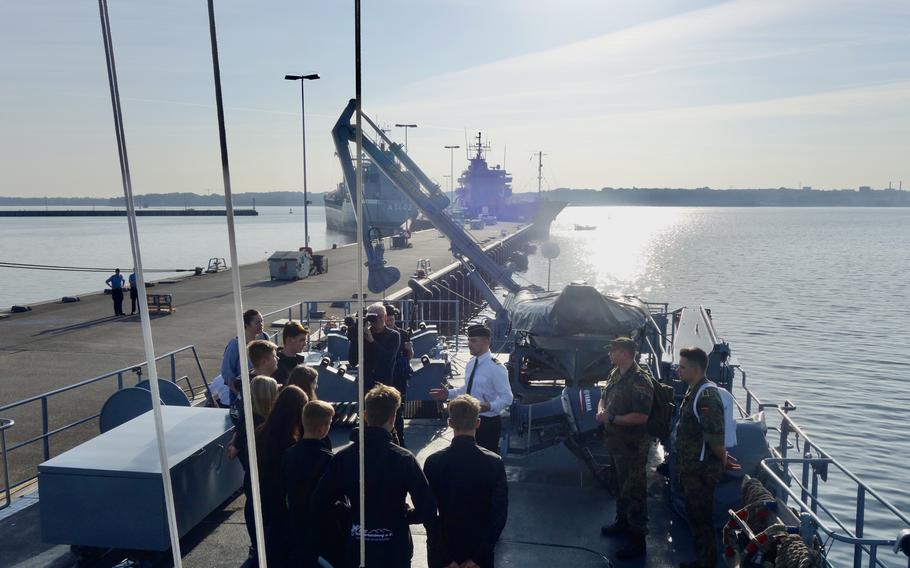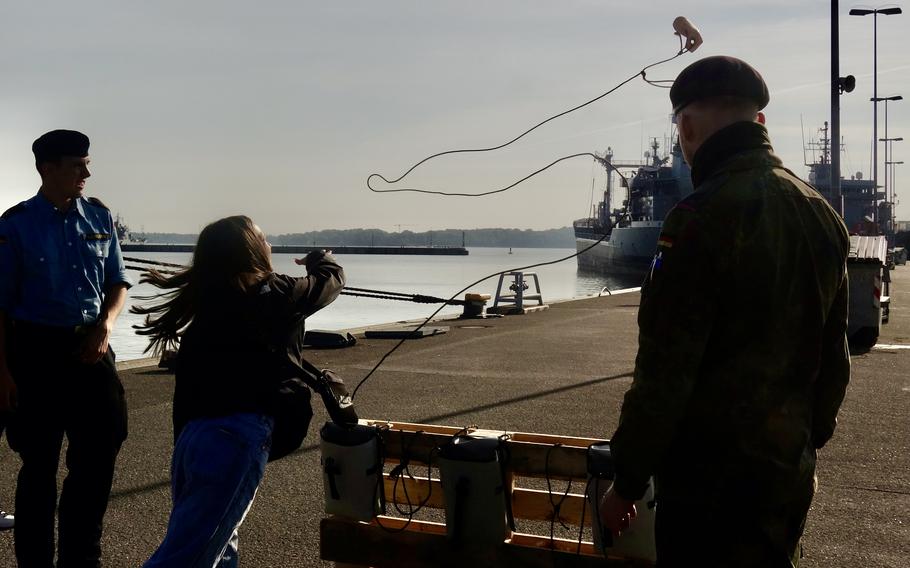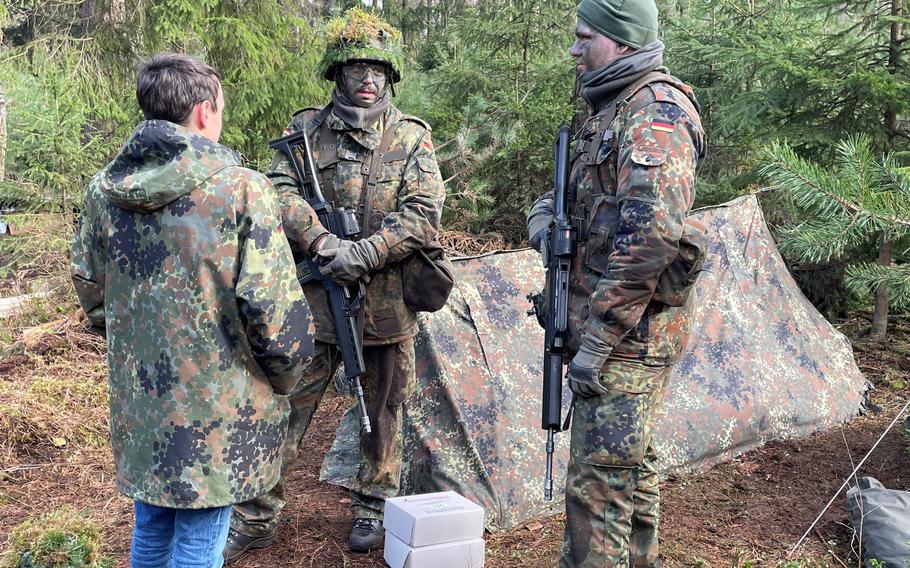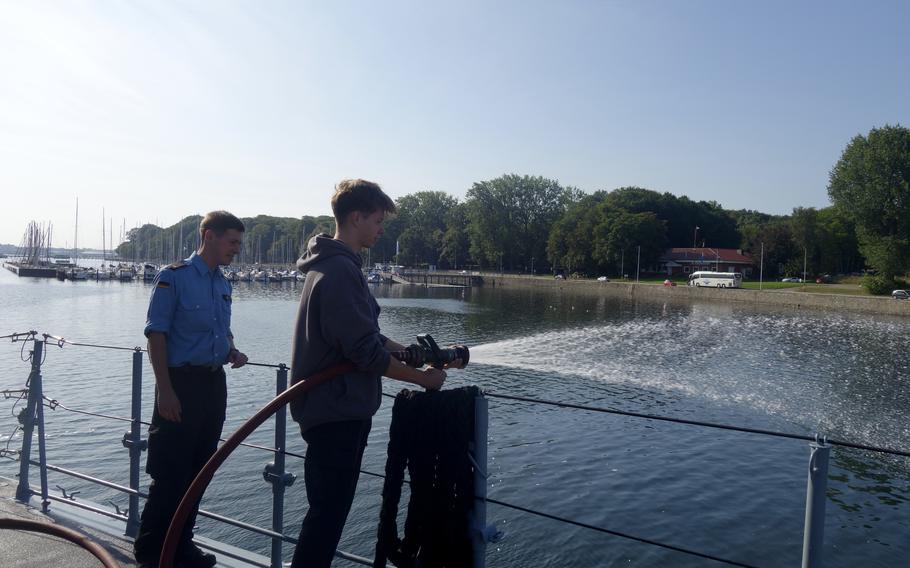
The crew of the minesweeper Dillingen greets participants of the German navy's "Marine Live" program in Kiel, Germany, on Aug. 27, 2024. (Svetlana Shkolnikova/Stars and Stripes)
KIEL, Germany — A minesweeper docked at the Kiel-Wik naval base on Germany’s Baltic Sea coast often serves as the first stop for Germans interested in getting a taste of life in the navy.
It is where 1,200 civilians per year, some as young as 15, begin a four-day immersion with the service that the German navy hopes will convert mere curiosity into a willingness to serve.
“We offer the possibility to get to know us,” said Sgt. Maj. Hans-Georg Szyza, head of the navy’s career orientation center. “How we live, how we eat, the climate we have onboard.”
So far, only about 10% of participants go on to become sailors, he said.
But the “Marine Live” program holds such promise for recruiting that the rest of the German military is also increasingly throwing open its doors to the public.
The goals are to reintroduce the Bundeswehr to a nation that scrapped conscription 13 years ago and to bridge a civil-military divide that has made attracting recruits a widespread struggle, including in the United States.
“The military totally went out of everyday life,” said Falko Drossmann, a lawmaker in Germany’s parliament on leave from the air force. “You don’t see soldiers, you don’t see weapons. People lost connection to the military and we have to bring that back.”

Participants in the "Marine Live" program practice throwing heaving lines with sandbags in Kiel, Germany, on Aug. 27, 2024. (Svetlana Shkolnikova/Stars and Stripes)
Russia’s full-scale invasion of Ukraine in 2022 has set off a scramble for troops in Germany. The Bundeswehr is aiming to grow its ranks from 180,000 to more than 200,000 amid predictions from senior German military leaders that Russia’s reconstituted forces will be strong enough within five to eight years to attack NATO territory, if Moscow chooses to do so.
Obstacles toward Germany reaching its lofty recruiting goal are numerous: stiff competition with the civilian sector, a steady stream of service member retirements and most alarming for recruiting officials, a lack of awareness about what the military does.
“Young people don’t even know what the Bundeswehr is,” Szyza said. “They can’t even imagine what we offer.”
The Marine Live program is one attempt to enlighten them.
In Kiel, participants try their hand at throwing heaving lines, sleep in barracks, eat food prepared on a ship, visit specialized units on land and sea, speak with sailors and if the geopolitical situation permits, voyage aboard a frigate.
All costs are covered by the navy, including meals and accommodation. Most who apply are male and under 30, though the program cuts off at age 40, Szyza said.
Preference is given to applicants with experience in technical fields, where the navy has more vacancies.
A recent group of visitors included a class of 10th graders who traveled 10 hours to Kiel from Olbernhau, a small town in Saxony by the Czech border. Their teacher, Sabine Ullmann, wanted to expose them to a career few, if any, considered.
“This is to open their mind, to open their horizons,” Ullmann said. “The military is in my opinion difficult but somebody must do it because of the crises around the world. Not everyone can say, ‘No, not for me.’”
Even a decision not to serve is considered a successful outcome for the Marine Live program.
“It’s important that people can say, ‘No, I’ll never do that’ when they’ve been here, that they now know for sure before they accept going to the navy and they’re desperately unhappy,” Szyza said. “Because then in that case we’ve done everything right.”
Thore, a 16-year-old in Ullmann’s class, was one of those people. He enjoyed seeing the engine room on the minesweeper but the cramped quarters where sailors sleep confirmed the sacrifice of life at sea.
“You are gone from home and that’s my main problem,” he said. “I don’t like being far away, it doesn’t suit me.”

A visitor talks to German troops during "Heer Live," at the German armed forces' Army Visiting Center in Munster, Germany. (German armed forces/Army Visiting Center)
The Bundeswehr has doubled down on efforts to give potential recruits as much hands-on access as possible. Its careers website offers a constantly updating roster of events, from four days with a helicopter squadron to five days with the mountain infantry in the Bavarian Alps.
Many opportunities are new additions this year, said Peter Levens, a career advisor for the Bundeswehr. The German army, inspired by the navy, launched “Heer Live” late last year. “Heer” is the German word for army.
“We have a recruiting strategy which is now based on this,” Levens said. “It’s useful, it’s promising.”
It also helps close a growing gap between civilians and the armed forces that has hampered recruiting not just in Germany, but also in the U.S. and other Western countries, said Katherine Kuzminski, an expert on the military and society at the Center for New American Security.
“Military installations tend to be further and further away from population centers,” she said. “We see that a lot of individuals who serve in the military come from a family with military service, which means that there’s a bigger separation between people who know what the military actually looks like, what it feels like, what the experience is like and the rest of the population.”
The end of conscription — in 1973 in the U.S. and in 2011 in Germany — has played a role in the divide, Kuzminski said, though it has also produced all-volunteer militaries that are more professionalized.
Germany’s need for troops is so great that it is considering bringing back a form of mandatory service. Defense Minister Boris Pistorius proposed a model in June that would use a questionnaire filled out by all young men to select the most suitable and motivated.
The U.S. also has waded into the conscription debate. Congress this year voted on long-shot proposals to make registering for the draft automatic and expand the registration requirement to women.
Neither measure is expected to become law, however, and the U.S. has no plans to reinstate the draft.
Lawmakers and military leaders remain stuck on how to address a chief stumbling block for recruiting: a “precipitously” declining interest among young people to serve, according to Kuzminski.
“The problem is this willingness piece and other countries are facing the same challenge,” she said.

Cpl. Joris Emmrich, left, shows participants in the "Marine Live" program how to perform ship firefighting duties in Kiel, Germany, on Aug. 27, 2024. (Svetlana Shkolnikova/Stars and Stripes)
Cpl. Joris Emmrich, 19, said he was unique among his peers in Bonn, a city in western Germany, for wanting to join the Bundeswehr. He enlisted in the navy right after school because that’s where his grandfather served.
“It really is family tradition that made me join,” he said. “Generally, among my age group, there aren’t so very many who want to join. My friends were happy for me but they didn’t want to do it themselves.”
Similar attitudes are prevalent in the U.S., with Defense Department polling showing only 9% of young people have a propensity to enlist. Of those who sign up for the Army, for example, 80% have a family member who was in uniform.
The U.S. Navy has taken perhaps the most drastic measures of all the services to fill its ranks. In late 2022, it began accepting low qualification test scores and this year started to enlist people who didn’t have a high school diploma or a GED.
Navy officials credited the new policies, as well as a prep course to improve fitness and academic performance, for enabling the service to meet its 2024 recruiting goal after several years of shortfalls.
Rear Adm. James Waters, head of the Navy’s recruiting command, said the service also has a community outreach component that offers, among other things, visits to bases, ships and aircraft for educators so they can “take that experience back” to young people.
In Kiel on a recent morning, German teenagers received such experiences firsthand. They practiced firefighting on a ship and after lunch with sailors, met with navy divers. The next day they were bused 20 miles north to the city of Eckernförde to check out a naval beach battalion.
Levens, the Bundeswehr career advisor, said the military is still “a long way away from reaching the numbers we want” but has seen some growth.
The public’s interest in trying out the Bundeswehr, as evidenced by the fully booked Marine Live, is one encouraging bright spot, he said. Another is the unexpected rekindling of respect for the military in a country that deeply committed to pacifism after World War II.
Shortly after Russian tanks rolled into Ukraine, Levens said civilians began approaching German troops in uniform and thanking them for their service.
“It was very surprising — I didn’t even know what I did, what they were thanking me for ... but it makes you proud,” he said. “The position of the Bundeswehr has changed in the eyes of the people.”